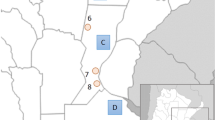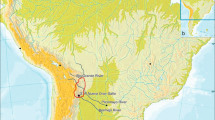Abstract
Argentinean Patagonia is inhabited by people that live principally in urban areas and by small isolated groups of individuals that belong to indigenous aboriginal groups; this territory exhibits the lowest population density of the country. Mapuche and Tehuelche (Mapudungun linguistic branch), are the only extant Native American groups that inhabit the Argentinean Patagonian provinces of Río Negro and Chubut. Fifteen autosomal STRs, 17 Y-STRs, mtDNA full length control region sequence and two sets of Y and mtDNA-coding region SNPs were analyzed in a set of 434 unrelated individuals. The sample set included two aboriginal groups, a group of individuals whose family name included Native American linguistic root and urban samples from Chubut, Río Negro and Buenos Aires provinces of Argentina. Specific Y Amerindian haplogroup Q1 was found in 87.5 % in Mapuche and 58.82 % in Tehuelche, while the Amerindian mtDNA haplogroups were present in all the aboriginal sample contributors investigated. Admixture analysis performed by means of autosomal and Y-STRs showed the highest degree of admixture in individuals carrying Mapuche surnames, followed by urban populations, and finally by isolated Native American populations as less degree of admixture. The study provided novel genetic information about the Mapuche and Tehuelche people and allowed us to establish a genetic correlation among individuals with Mapudungun surnames that demonstrates not only a linguistic but also a genetic relationship to the isolated aboriginal communities, representing a suitable proxy indicator for assessing genealogical background.





Similar content being viewed by others
References
Corach D, Marino M, Sala A (2006) Relevant genetic contribution of Amerindian to the extant population of Argentina. Prog Forensic Genet 11(1288):397–399
Corach D, Lao O, Bobillo MC, van Der Gaag K, Zuniga S, Vermeulen M, van Duijn K, Goedbloed M, Vallone PM, Parson W, deKnijff P, Kayser M (2010) Inferring continental ancestry of Argentineans from autosomal, Y-chromosomal and mitochondrial DNA. Ann Hum Genet 74:65–76
Avena S, Via M, Ziv E, Perez-Stable EJ, Gignoux CR, Dejean C, Huntsman S, Torres-Mejia G, Dutil J, Matta JL, Beckman K, Burchard EG, Parolin ML, Goicoechea A, Acreche N, Boquet M, Rios Part Mdel C, Fernandez V, Rey J, Stern MC, Carnese RF, Fejerman L (2012) Heterogeneity in genetic admixture across different regions of Argentina. PLoS ONE 7(4):e34695
Martinez Sarasola C (2005) Nuestros paisanos los indios. EmecéEdts, Buenos Aires
Dana LP (2006) Indigenous peoples in Chile. Int J Entrepreneurship Small Bus 3:779–786
García F, Moraga M, Vera S, Henríquez H, Llop E, Aspillaga E, Rothhammer F (2006) mtDNA microevolution in Southern Chile’s archipelagos. Am J Phys Anthropol 129:473–481
Loukotka C (1968) Classification of South American Indian languages. Latin American Studies Center, University of California Press, Berkeley
Greenberg JH, Turner CG, Zegura SL, Campbell L, Fox JA, Laughlin WS, Szathmary EJE, Weiss KM, Woolford E (1986) The settlement of the Americas: a comparison of the linguistic, dental and genetic evidence. Curr Anthropol 27:477–497
Ruhlen MJ, Greenberg J (2007) An Amerindian etymological dictionary. Stanford University Press, Stanford
Latchan RE (1922) La organización social y la creencia de los antiguos araucanos. Rev Museo Hist Nat 3:245–868
Faron LC (1956) Araucanian Patri-Organization and the Omaha system. Am Anthropol 58:435–456
Silva Galdanes O (1984) Los Araucanos Prehispanos ¿Un Caso de Doble Filiación? Boletín del Museo Regional de la Araucanía Temuco 1:41–46
Lehmann-Nitsche R (1921) El grupo lingüístico Alakaluf de los canales magallánicos. Revista del Museo de La Plata, Buenos Aires
Escalada F (1949) El complejo tehuelche. Estudios de etnografía patagónica. Instituto Superior de Estudios Patagónicos Press, Buenos Aires
Casamiquela R (1965) Rectificaciones y ratificaciones hacia una interpretación definitiva del panorama etnológico de la Patagonia y área septentrional adyacente. Instituto de Humanidades: Universidad Nacional del Sur Press, Bahía Blanca
Casamiquela R (1969) Un nuevo panorama etnológico del área pampeana y patagónica adyacente. Pruebas etnohistóricas de la filiación tehuelche septentrional de los guaraníes. Museo Nacional de Historia Natural Press, Santiago de Chile
Sala A, Penacino G, Carnese R, Corach D (1999) Reference database of hypervariable genetic markers of Argentina: applications for molecular anthropology and forensic casework. Electrophoresis 208:1733–1739
Quinque D, Kittler R, Kayser M, Stoneking M, Nasidze I (2006) Evaluation of saliva as a source of human DNA for population and association studies. Anal Biochem 15:272–277
Marino M, Sala A, Corach D (2007) Genetic attributes of the YHRD minimal haplotype in 10 provinces of Argentina. Forensic Sci Int Genet 1:129–133
Y Chromosome Haplotype Reference Database. http://www.yhrd.org
Brandstätter A, Niederstatter H, Parson W (2004) Monitoring the inheritance of heteroplasmy by computer-assisted detection of mixed basecalls in the entire human mitochondrial DNA control region. Int. J. Legal Med. 118:47–54
Zuccarelli G, Alechine E, Caputo M, Bobillo MC, Corach D, Sala A (2011) Rapid screening for Native American mitochondrial and Y-chromosome haplogroups detection in routine DNA analysis. Forensic Sci Int Genet 5:105–108
Excoffier L, Laval G, Schneider S (2005) Arlequin ver. 3.0: an integrated software package for population genetics data analysis. Evol Bioinform Online 1:47–50
Slatkin M (1993) Isolation by distance in equilibrium and non-equilibrium populations. Evolution 41:264–279
Nei M (1987) Molecular Evolutionary Genetics. Columbia University Press, New York
Kayser M, Caglia A, Corach D, Fretwell N, Gehrig C, Graziosi G, Heidorn F, Herrmann S, Herzog B, Hidding M, Honda K, Jobling M, Krawczak M, Leim K, Meuser S, Meyer E, Oesterreich W, Pandya A, Parson W, Penacino G, Perez-Lezaun A, Piccinini A, Prinz M, Schmitt C, Roewer L et al (1997) Evaluation of Y-chromosomal STRs: a multicenter study. Int J Legal Med 110:125–133
Brinkmann C, Forster P, Schürenkamp M, Horst J, Rolf B, Brinkmann B (1999) Human Y chromosomal STR haplotypes in a Kurdish population sample. Int J Leg Med 112:181–183
Bertorelle G, Excoffier L (1998) Inferring admixture proportions from molecular data. Mol Biol Evol 15:1298–1311
Dupanloup I, Bertorelle G (2001) Inferring admixture proportions from molecular data: extension to any number of parental populations. Mol Biol Evol 18:672–675
Zhivotovsky LA, Underhill PA, Cinnioğlu C, Kayser M, Morar B, Kivisild T, Scozzari R, Cruciani F, Destro-Bisol G, Spedini G, Chambers GK, Herrera RJ, Yong KK, Gresham D, Tournev I, Feldman MW, Kalaydjieva L (2004) The effective mutation rate at y chromosome short tandem repeats, with application to human population-divergence time. Am J Hum Genet 74:50–61
Pritchard JK, Stephens M, Donnelly P (2000) Inference of Population Structure Using Multilocus Genotype Data. Genetics 155:945–959
Bandelt HJ, Forster P, Sykes BC, Richards MB (1995) Mitochondrial portraits of human populations. Genetics 141:743–753
Bonferroni CE (1936) Teoria statistica delle classi e calcolo delle probabilità. Pubblicazioni del R Istituto Superiore di Scienze Economiche e Commerciali di Firenze 8:3–62
Jimenez JF (2002) Matrilinealidad versus patrilinealidad. La obra de Félix José de Augusta y la polémica acerca de la filiación entre los Reche Mapuche. Centro de Documentación Patagónica Eds, Bahía Blanca
Censabella M (2007) Las lenguas indígenas de la Argentina. Universidad de Buenos Aires Eudeba Eds, Buenos Aires
Merriwether DA (1993) Mitochondrial DNA variation in South American Indians. PhD Dissertation, University of Pittsburgh, Pittsburgh
Merriwether DA, Ferrell RE, Rothhammer F (1995) mtDNA D-loop 6-bp deletion found in the Chilean Aymara: not a unique marker for Chibcha-speaking Amerindians. Am J Hum Genet 56:812–813
Merriwether DA, Rothhammer F, Ferrell RE (1995) Distribution of the four founding lineage haplotypes in Native Americans suggests a single wave of migration for the New World. Am. J. Phys. Anthropol. 98:411–430
Santos M, Barrantes R (1994) D-Loop mtDNA deletion is a unique marker of Chibchan Americans. Am J Hum Genet 55:413–414
Perego UA, Achilli A, Angerhofer N, Accetturo M, Pala M, Olivieri A, Kashani BH, Ritchie KH, Scozzari R, Kong QP, Myres NM, Salas A, Semino O, Bandelt HJ, Woodward SR, Torroni A (2009) Distinctive Paleo-Indian migration routes from Beringia marked by two rare mtDNA haplogroups. Curr Biol 19:1–8
Perego UA, Angerhofer N, Pala M, Olivieri A, Lancioni H, Kashani BH, Carossa V, Ekins JE, Gomez-Carballa A, Huber G, Zimmermann B, Corach D, Babudri N, Panara F, Myres NM, Parson W, Semino O, Salas A, Woodward SR, Achilli A, Torroni A (2010) The initial peopling of the Americas: a growing number of founding mitochondrial genomes from Beringia. Genome Res 20:1174–1179
Bodner M, Perego UA, Huber G, Fendt L, Röck A, Zimmermann B, Olivieri A, Gómez-Carballa A, Lancioni H, Angerhofer N, Bobillo MC, Corach D, Woodward SR, Salas A, Achilli A, Torroni A, Bandelt HJ, Parson W (2012) Rapid coastal spread of First Americans: novel insights from South America’s Southern Cone mitochondrial genomes. Genome Res. doi:10.1101/gr.131722.111
Ginther C, Corach D, Penacino GA, Rey JA, Carnese RF, Hutz MH, Anderson A, Just J, Salzano FM, King MC (1993) Genetic variation among the Mapuche Indians from the Patagonian region of Argentina: mitochondrial DNA sequence variation and allele frequencies of several nuclear genes. Exs 67:211–219
Moraga ML, Rocco P, Miquel JF, Nervi F, Llop E, Chakraborty R, Rothhammer F, Carvallo P (2000) Mitochondrial DNA polymorphisms in Chilean Aboriginal populations: implications for the Peopling of the Southern Cone of the Continent. Am J Phys Anthropol 113:19–29
Bobillo MC, Zimmermann B, Sala A, Huber G, Röck A, Bandelt HJ, Corach D, Parson W (2010) Amerindian mitochondrial DNA haplogroups predominate in the population of Argentina: towards a first nationwide forensic mitochondrial DNA sequence database. Int J Legal Med 124:263–268
Achilli A, Perego UA, Bravi CM, Coble MD, Kong QP, Woodward SR, Salas A, Torroni A, Bandelt HJ (2008) The phylogeny of the four pan-American MtDNA haplogroups: implications for evolutionary and disease studies. PLoS ONE 3(3):e1764
Kolman CJ, Bermingham E, Cooke R, Ward RH, Arias TD, Guionneau-Sinclair F (1995) Reduced mtDNA diversity in the Ngobe Amerinds of Panama. Genetics 140:275–283
Gayà-Vidal M, Moral P, Saenz-Ruales N, Gerbault P, Tonasso L, Villena M, Vasquez R, Bravi CM, Dugoujon J-M (2011) mtDNA and Y-chromosome diversity in Aymaras and Quechuas from Bolivia: different stories and special genetic traits of the Andean Altiplano populations. Am J Phys Anthropol 145:215–230
Blanco-Verea A, Jaime JC, Brión M, Carracedo A (2010) Y-chromosome lineages in native South American population. Forensic Sci Int Genet 4:187–193
Haplogroup Predictor. http://www.hprg.com/hapest
Acknowledgments
We would like to thank Dr. RF Carnese for kindly providing the aboriginal samples during the early ’90s and Dr. L. Saccomanno and S. Vannelli for helping in the sampling process of the Patagonian samples. This work was partly supported, by grants UBACyTB047, 2008–2010; UBACyT 2011-2014, Code 20020200100744, to DC and grant PIP 11420090100232-CONICET to AS.
Author information
Authors and Affiliations
Corresponding authors
Additional information
Daniel Corach and Andrea Sala are members of National Research Council of Argentina (Carrera del Investigador del Consejo Nacional de Investigaciones Científicas y Tecnológicas, CONICET).
Electronic supplementary material
Below is the link to the electronic supplementary material.
Rights and permissions
About this article
Cite this article
Sala, A., Corach, D. Analysis of admixture and genetic structure of two Native American groups of Southern Argentinean Patagonia. Mol Biol Rep 41, 1533–1543 (2014). https://doi.org/10.1007/s11033-013-2999-z
Received:
Accepted:
Published:
Issue Date:
DOI: https://doi.org/10.1007/s11033-013-2999-z




